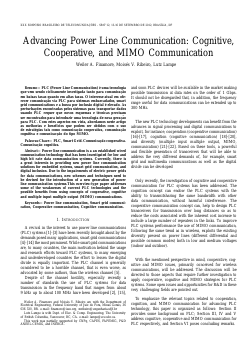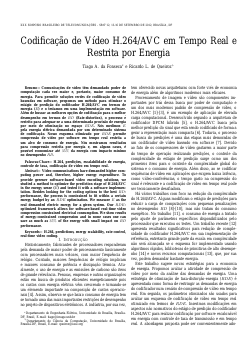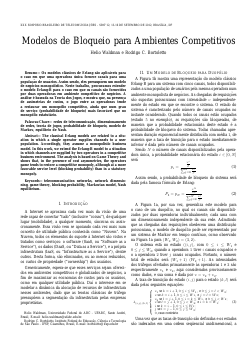
XXX Simpósio Brasileiro de Telecomunicações

Low-complexity widely linear RLS filter using DCD iterations
Fernando G. Almeida Neto, Vítor H. Nascimento, Yuriy V. Zakharov
DOI: 10.14209/sbrt.2012.32
Keywords: Widely linear estimation Reduced-complexity estimation Reduced-complexity widely linear RLS Dichotomous coordinate descent (DCD) algorithm
Abstract
Widely linear (WL) adaptive filters have been receiving much attention recently, since they take advantage of the full second-order statistics of improper signals. While this approach provides estimation gains if compared to their strictly linear (SL) counterparts,WL algorithms generally present higher computational complexity. In order to reduce the computational cost, we presented in a previous paper a reduced-complexity (RC) version of the WL-RLS algorithm – the RC-WL-RLS algorithm – which was shown to be 4 times less expensive than the WLRLS, but still keeps the O(N2) complexity (where N is the length of the regressor vector). In this paper, we modify the RCWL- RLS, applying the dichotomous coordinate descent (DCD) algorithm to iteratively solve the normal equations. With this approach, we reduce the number of multiplications per iteration and obtain a numerically stable widely-linear RLS algorithm with computational complexity linear on N. Simulations are presented to support our approach.Download

No-Reference Video Quality Assessment Method based on the Levenberg-Marquardt Minimization
Wyllian B. Silva, Alexandre A. P. Pohl
DOI: 10.14209/sbrt.2012.31
Keywords: Levenberg-Marquardt algorithm no-reference metric objective video quality assessment
Abstract
The processing and transmission of digital video are impaired by degradations that impact its quality. Evaluation tools are then required to assess the quality of transmitted video. In this work we present a no-reference assessment metric based on an analytical method, which takes into account distinct weights for the spatial-temporal descriptors and whose values are obtained by the solution of a nonlinear least squares problem using the Levenberg-Marquardt algorithm.Download

Sistemas de Informação MIMO: Desempenho, Limitantes e Perspectivas
Charles Casimiro Cavalcante, Antônio Alisson Pessoa Guimarães, Raymundo Nogueira de Sá Netto, Walter da Cruz Freitas Júnior
DOI: 10.14209/sbrt.2012.33
Keywords:
Abstract
Este trabalho aborda os aspectos de processamento estatístico de sinais e teoria da informação para supressão (cancelamento) de interferência em sistemas com múltiplas entradas e múltiplas saídas (MIMO, do inglˆes multiple input multiple output) e aspectos de modelagem considerando aspectos geométricos nos sistemas de recuperação da informação. As ferramentas das quais lançamos mão neste trabalho permitem uma aplicação em um grande número de sistemas de informação, não só no problema clássico de comunicações digitais, tais como processamento de voz, imagens, além de áreas por vezes menos conhecidas da comunidade de processamento de sinais, como por exemplo sensoriamento remoto e desconvolução sísmicaDownload

Sobre a detecção e a estimação de parâmetros de sinais neuronais
Maria D. Miranda, Marcio Eisencraft
DOI: 10.14209/sbrt.2012.184
Keywords:
Abstract
A necessidade da observação de regiões específicas do cérebro para a estimulação controlada, seja com fins medicinais ou de interação homem-máquina, vem despertando um crescente interesse em técnicas eficientes de detecção e estimação de parâmetros de sinais neuronais. Apesar de muitas soluções para realizar o spike sorting terem sido propostas, nenhuma solução foi aceita como universal e este assunto continua em aberto. Entre as dificuldades para a obtenção de métodos eficientes destacasse o fato de não haver uma solução ótima. Assim o problema ´e bem mais complicado do que acontece em geral em Telecomunicações, em que temos uma constelação finita com características bem especificadas e não se conhece o canal de comunicação. Nesse trabalho propomos uma abordagem unificada para avaliação das técnicas usuais de detecção baseadas em limiar. Pretende-se associar as vantagens e limites de bom desempenho das técnicas de detecção com as características das diferentes séries temporais consideradas. A fim de reduzir o custo computacional da etapa de classificação, técnicas de parametrização que usam os parâmetros de predição linear são sugeridas no contexto da série temporal de interesse.Download

Stochastic Analysis of the Orthogonal Frequency Division Multiplexing Scheme
Marcelo S. Alencar, Francisco Madeiro, Wamberto J. L. Queiroz, Waslon T. A. Lopes
DOI: 10.14209/sbrt.2012.34
Keywords: OFDM stochastic analisys.
Abstract
The Orthogonal Frequency Division Multiplexing (OFDM) scheme has been chosen as the transmission scheme for most digital television, digital radio and wireless standards. In this scheme the sub-carriers form a set of functions that are orthogonal to each other, that is, the integral of the product between any two of these functions within the interval of a symbol is null. The orthogonality ensures that the inter-symbolic interference in the frequencies of the sub-carriers is null. This paper presents an stochastic analysis of the OFDM signal, to obtain general expressions for its autocorrelation and power spectral density formulas. The resulting power spectral density is exactly what is produced by practical spectrum analyzers.Download

Advancing Power Line Communication: Cognitive, Cooperative, and MIMO Communication
Weiler A. Finamore, Moisés V. Ribeiro, Lutz Lampe
DOI: 10.14209/sbrt.2012.35
Keywords: Power line communication Smart grid communication Cooperative communication Cognitive communication
Abstract
Power line communication is a an established wired communication technology that has been investigated for low and high bit rate data communication systems. Currently, there is a great interests in providing new power line communication solutions for embedded systems, smart grid communication, and digital inclusion. Due to the impairments of electric power grids for data communications, new schemes and techniques need to be devised for the introduction of a new generation of power line communication systems.This overview-type paper addresses some of the weaknesses of current PLC technologies and the possible benefits from using concepts of cooperative, cognitive and multiple input multiple output (MIMO) communications.Download

Modulação Codificada para Comunicações Ópticas
Cristiano M. Gallep, Jaime Portugheis, Leonardo L. Bravo-Roger, Felipe K. G. Hoshino, Marcos S. Gonçalves, Rangel Arthur
DOI: 10.14209/sbrt.2012.36
Keywords: Optical transmission systems high spectral efficiency coded modulation.
Abstract
Modulação codificada é uma ferramenta básica para simultaneamente melhorar o desempenho e aumentar a eficiência espectral de um sistema de transmissão digital. Nos últimos anos vários esquemas de modulação codificada foram propostos como candidatos a serem utilizados em sistemas de transmissão óptica que operam com eficiências espectrais altas. O objetivo deste artigo é discutir estes esquemas e comentar sobre desafios peculiares de projeto e implementação dos mesmos.Download

Codificação de Vídeo H.264/AVC em Tempo Real e Restrita por Energia
Tiago A. da Fonseca, Ricardo L. de Queiroz
DOI: 10.14209/sbrt.2012.37
Keywords: H.264 predições escalabilidade de energia controle de taxa codificação de vídeo em tempo real.
Abstract
Video communications have demanded higher computing power and, therefore, higher energy expenditure. To provide greener software-based video encoding solutions, we studied a method to optimize the prediction stage of H.264/AVC in the energy sense (E) and tested it with a software implementation. Besides looking for the coding options to the best RDperformance, the process is constrained to fit within a certain energy budget by an RDE optimization. We measure E as the real demanded electric energy for a given system. Our RDEoptimized framework allows for software-based real-time video compression constrained electrical consumption. We show results of energy-constrained compression and in some cases one can save as much as 35% of the energy with small impact on RD performance.Download

Processamento de Sinais Acústicos: Efeito de Distorções Não-Estacionárias na Classificação de Sinais de Voz
R. Coelho, L. Zão, D. Cavalcante
DOI: 10.14209/sbrt.2012.40
Keywords: speech signal classification acoustic distortion non-stationary noise and emotion sources
Abstract
Speech classification systems showed to be very interesting for many applications with security needs, such as access control, electronic bank transactions authentication, forensics and biomedical signal processing. Several studies and experiments confirmed that these systems achieve high recognition rates when considering clean or neutral speech signals. However, their performance can be severely degraded when the speech signals are affected by environmental noises (plane, train, car, siren, machine gun) or acoustic emotion (anger, fear, sadness). This paper highlights some solutions proposed in the literature that could improve the robustness of the speech classification systems to these acoustic distortions.Download

Modelos de Bloqueio para Ambientes Competitivos
Helio Waldman, Rodrigo C. Bortoletto
DOI: 10.14209/sbrt.2012.38
Keywords: telecommunication networks network dimensioning game-theory blocking probability Markovian model Nash equilibrium.
Abstract
The classical Erlang models are related to a situation in which a single operator supplies channels to a user population. Accordingly, they assume a monopolistic business model. In this work, we extend the Erlang-B model to a situation in which channels are supplied by two operators in a competitive business environment. The analysis is based on Game Theory and shows that, in the presence of cost asymmetries, the operators game tends to restore a competitive monopoly, although at a more favorable service level (blocking probability) than in a statutory monopoly.Download